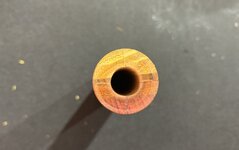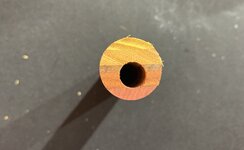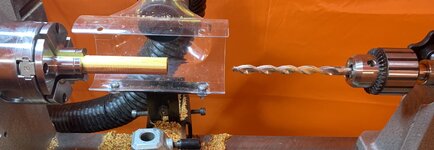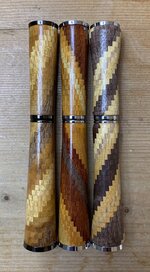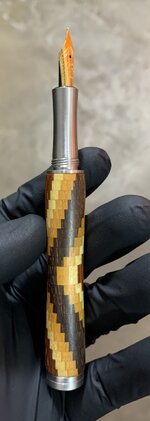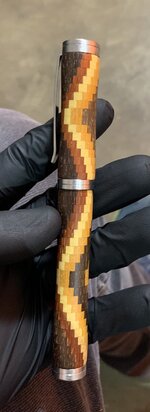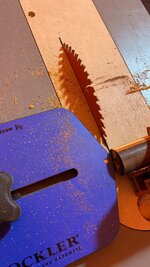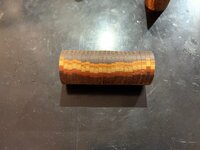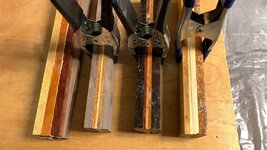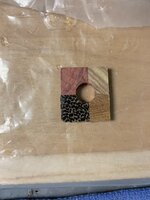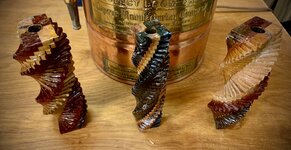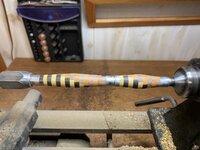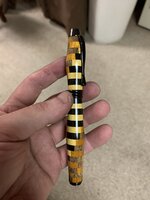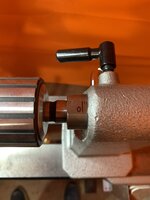OK Joshua let me first say many times when people ask questions they forget sometimes we were not standing there with them when something went wrong. We rely on photos a great deal because it helps tell the story. No one knew you because you are new here and we had no idea you were drilling and working your pens with a different set of tools and methods so when you show us rather sophisticated segmented pens we have to think you have been at this for some time and now the questions get different than for someone who is just starting out. Your explanation makes sense now.
I understand -- I was speaking to KenB's post, which was, point blank, a snide and unscrupulous remark that held no merit. He's a schuck. In my original, unedited thread opener I say that I've "recently transitioned to using my lathe for drilling". I'll leave it at that as it doesn't justify additional discussion and every other member, including yourself has been remarkably gracious and helpful.
Drilling on a lathe is more accurate for many reasons but you need to start at the beginning. That chuck you are using and those jaws do not support the blank all that well. You have quite abit of material unsupported and you are trying to drill a hole dead center. I will ask is that blank square?? The reason I ask that is a 4 point chuck you are using and if it is not square then it will find its own center when tightened. I prefer a chuck that has 2 points of contact because no matter what way you put it in the chuck it finds dead center. When you had blank chucked up did it spin true or did it have a wobble?? Spinning at a lower rpm will help you see this better and for drilling you should drill slower which you acknowledge.
Yes, you are right about material unsupported. As you probably have figured, I need quite a bit of length to begin with in order to make segmented blanks such as these. When you're cutting some 15-20 different 3mm segments, much is lost to blade kerf. If you know of longer jaws or a better alternative, I'd be glad to hear. As for the blank being square, I'm not sure I understand. The ends should be square, yes, but if you're asking if the diameter of the circular blank is consistent along the entire length of the blank, I think not. While I take pride in my turning skills, I am not so precise and I wouldn't know how to accurately test this. I do have the PSI pen chuck, which is a 2-point chuck though it appears to be primarily intended for square blanks. Perhaps I could try using this, though I wonder if it would suffice with a round blank? For the wobbling I'm not certain and that will need to be checked again once the RPM is lowered.
Now I know those are suppose to be aa new version of pen blank drilling bits but I prefer standard twist bits. Stay away from brad point bits!! These are similar in that they have a point that can follow a grain pattern more easily that standard twist bits. I say this because standard twist bits have a bevel on each side and the point is part of the bevel as opposed to those where it is the leading part of the bit. You may want to try a standard twist bit in place of those and see if that helps.
Backing out and clearing the swarf is important and also keeping the bit cool is as well. Need to drill slowly. I try not to extend the quill too far out when drilling. I rather move the tailstock and repeat procedure. To do that just recoil the quill and push the tailstock forward and then the bit is pushed in hole. Now restart lathe but make sure you are not pushed in too far where the bit is hitting the bottom of the hole or else it will grab on you and could break the blank. Hold the drill chuck as normal and continue drilling. Rinse and repeat as many times as needed. Many times when drilling long blanks like that it is better to do it from both ends. That is what I do.
Segmented blanks such as what you are doing have different woods used which have different hardness and grain patterns so extra care is needed and going slow will help. Good luck. You will find that sweet spot for sure.
Will stay away from the brad point bits. I don't have any standard twist bits, but I can check at my father's workshop. I would hate though to give up these flutes, as I've purchased many sizes at significant cost...
For the other tips, I've already written them down and intend to put into practice.
Thanks again, your help (and many others here) has been invaluable. I simply need to experiment a bit, which I hope to do in the next few days. I'll report back with what I find.
Best,
Josh

